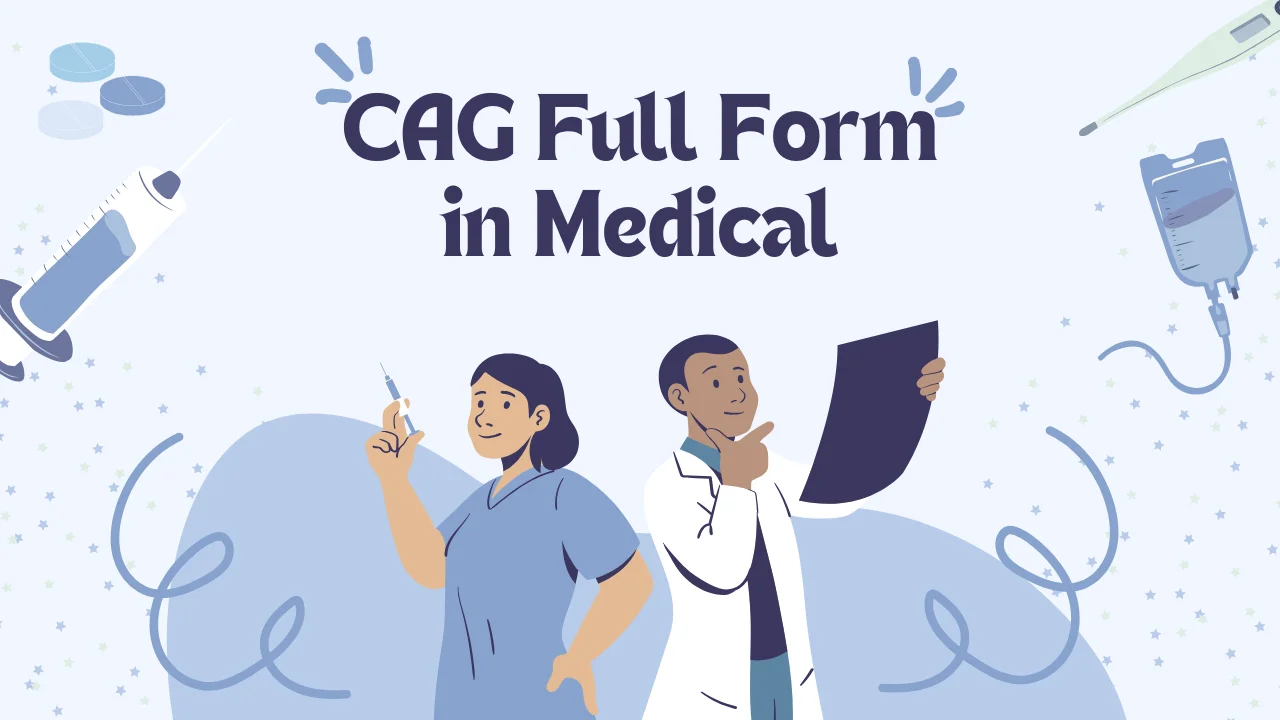CAG Full Form in Medical How to Read Your Report
In medicine, we often come across abbreviations that can be confusing at first. One such term is CAG, which many people hear when visiting a hospital for heart-related issues. The CAG full form in medical is Coronary Angiography, a vital diagnostic test that allows doctors to see the condition of the heart’s arteries and detect blockages or narrowing that may affect blood flow.
Just like the RSCIT Full Form is important in education, understanding medical abbreviations helps patients grasp procedures better. Knowing what CAG means empowers you to understand your treatment and communicate more confidently with your healthcare provider.
What is CAG Full Form in Medical?
The cag full form in medical—Coronary Angiography—is a special X-ray test that shows how blood flows through the arteries in the heart. It helps detect any narrowing or blockage that may stop the heart from receiving enough oxygen-rich blood.
Doctors use this test to understand whether a person needs further treatment such as stenting, medication, or surgery. It is one of the most accurate ways to see the heart’s blood vessels in detail.
During the procedure, a dye (contrast material) is injected into the arteries, and images are captured using an X-ray camera. These images give doctors a clear view of the heart’s blood supply and any problems that may exist.
Why Is CAG Important?
Knowing the cag form in medical is helpful because Coronary Angiography plays a major role in diagnosing and preventing heart attacks. It is the gold standard test to detect coronary artery disease (CAD), which happens when arteries become narrow or blocked.
When a patient complains of chest pain, dizziness, or shortness of breath, doctors may recommend a CAG. This test helps determine whether blood flow is restricted in any artery. It allows early detection and treatment, which can prevent serious heart complications.
The procedure not only helps in diagnosis but also provides real-time information. If a blockage is detected, the doctor may perform angioplasty immediately during the same session.
How Is Coronary Angiography Done?
A CAG is usually done in a cardiac catheterization lab, also called a Cath Lab. The process takes about 30 to 60 minutes. It is a safe and controlled procedure performed by a team of cardiologists and nurses.
First, the doctor cleans and numbs an area on your wrist or groin using a local anesthetic. Then, a thin flexible tube called a catheter is inserted into an artery. The catheter is carefully guided to the heart’s arteries using live X-ray imaging.
Once it reaches the correct position, a contrast dye is injected. As the dye moves through your heart’s arteries, the X-ray machine records images. These images show where blockages or narrowings are present.
After the procedure, the catheter is removed, and pressure is applied to prevent bleeding. You may need to rest for a few hours before going home.
| Step | Description | Time Taken |
|---|---|---|
| 1. Preparation | Patient is asked to fast for 6–8 hours | 10–15 minutes |
| 2. Anesthesia | Local anesthesia applied on wrist or groin | 5 minutes |
| 3. Catheter Insertion | Tube inserted into artery | 10 minutes |
| 4. Dye Injection | Contrast dye injected for imaging | 5 minutes |
| 5. Imaging | X-ray captures the flow of blood | 10–15 minutes |
| 6. Recovery | Catheter removed and pressure applied | 1–2 hours |
This table shows how smooth and structured the process is. Even though it may sound complex, most patients complete it safely and painlessly.
Who Needs a CAG Test?

Doctors recommend CAG when they suspect a problem with the heart’s arteries. People who experience angina (chest pain), abnormal ECG results, or unexplained fatigue during exertion are often advised to take the test.
Here are common situations when Coronary Angiography is suggested:
- When chest pain worsens despite medication.
- After a heart attack to assess the damage.
- Before major heart surgery to evaluate artery health.
- For people with multiple risk factors like diabetes, high cholesterol, and hypertension.
By identifying artery blockages early, CAG helps prevent future heart attacks and improves the success rate of treatment.
After the CAG Procedure
Once the procedure is complete, you’ll rest in the hospital for observation. Nurses will monitor your pulse, blood pressure, and the site where the catheter was inserted.
If the test was done through the wrist, recovery is usually quick. When it’s done through the groin, you may need to lie flat for a few hours to avoid bleeding.
Most patients go home the same day. Your doctor will give you instructions about taking medicines, drinking water, and avoiding heavy activities for a short time.
| Aspect | Guidance |
|---|---|
| Rest | Take rest for 24 hours |
| Fluids | Drink plenty of water to flush out dye |
| Medications | Continue as advised by your doctor |
| Physical activity | Avoid lifting heavy objects for 2 days |
| Follow-up | Visit doctor for report discussion |
Following these guidelines helps ensure quick recovery and lowers any chance of complications.
Risks and Complications
While CAG is generally safe, every medical procedure has small risks. Knowing them helps you stay informed and prepared.
Possible risks include:
- Minor bleeding at the site of catheter insertion.
- Allergic reactions to the dye.
- Irregular heartbeat during or after the test.
- Kidney strain due to the contrast dye (rare).
Doctors always evaluate the patient’s health before the procedure to make sure it is safe. In most cases, benefits far outweigh the risks.
Decoding Your CAG Report
After your CAG, the cardiologist will study the images carefully. The results show whether your heart’s arteries are normal, narrowed, or blocked.
- Normal Results: No blockages; blood flows freely through all arteries.
- Abnormal Results: One or more arteries are narrowed, reducing blood flow.
- Severe Blockage: The doctor may suggest an angioplasty or bypass surgery.
You’ll discuss the next steps with your doctor based on how serious the findings are. Sometimes, medication is enough. In other cases, minor or major procedures are needed.
CAG vs. Other Heart Tests
Many people confuse CAG with other heart-related tests. To make it clearer, here’s a comparison of common procedures and their purpose.
| Test Name | Full Form | Type | Purpose | Invasiveness |
|---|---|---|---|---|
| CAG | Coronary Angiography | Imaging | Detect artery blockage | Invasive |
| ECG | Electrocardiogram | Electrical | Measure heart rhythm | Non-invasive |
| ECHO | Echocardiogram | Ultrasound | Check heart’s pumping function | Non-invasive |
| CT Angiography | Computed Tomography | Imaging | Visualize arteries using CT | Non-invasive |
This table highlights why the cag form in medical—Coronary Angiography—remains the most detailed and accurate test to detect coronary artery disease.
Linking Technology and Medical Acronyms
In the middle of healthcare advancements, we often see other abbreviations appear in hospital reports or tech-related systems. For example, technicians sometimes come across MSVP Full Form while working on medical software or imaging equipment. It shows how acronyms connect the fields of technology and medicine.
In the same way, understanding the cag form in medical connects patients with the technical side of their health. When you understand what CAG means, you take control of your treatment journey.
Lifestyle Changes After a CAG
Even if your CAG results are normal, maintaining good heart health is still important. Simple lifestyle changes can keep your arteries healthy and prevent future heart problems.
Eat a balanced diet with fruits, vegetables, and whole grains, avoid fried or processed foods, and exercise regularly. Quit smoking, limit alcohol, manage stress, and maintain a healthy weight to keep your heart strong and reduce the chances of needing more tests later.
Advantages of Coronary Angiography
The CAG procedure offers many benefits. It gives doctors an exact view of the heart’s condition and allows them to act quickly.
Main advantages include:
- Accurate detection of heart blockages.
- Immediate treatment options if needed.
- Improved patient outcomes after early diagnosis.
- Helps avoid heart attacks and major surgeries through early care.
Knowing the cag form in medical helps patients appreciate how vital this test is for detecting life-threatening heart issues.
Disadvantages and Limitations
Despite being highly effective, CAG has a few limitations. It is slightly invasive and requires exposure to X-rays and contrast dye. People with kidney problems must take extra care since the dye can affect kidney function.
It also may not detect very small vessel diseases or functional problems of the heart. That’s why doctors may combine CAG results with other tests for full diagnosis.
Final Thoughts
In conclusion, the cag full form in medical is Coronary Angiography, a crucial test that helps doctors clearly view the heart’s arteries to detect blockages or narrowing. It’s a safe, accurate, and often life-saving procedure that plays a vital role in heart care.
Just as knowing the RSCIT Full Form or MSVP Full Form adds clarity in other fields, understanding medical terms like CAG empowers you to take charge of your health. Staying informed, following medical advice, and living a heart-healthy lifestyle can help you maintain strong heart health and enjoy a longer, active life.






